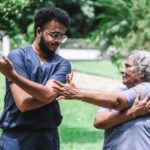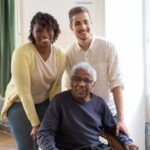As we age, maintaining independence and mobility becomes increasingly important, but one of the most significant risks to the well-being of seniors is the danger of falling. According to the Centers for Disease Control and Prevention (CDC), falls are the leading cause of injury-related deaths and hospitalizations among older adults in the United States (CDC, 2021). As a home care agency, ensuring that seniors are safe in their homes is at the forefront of what we do. In this blog post, we will delve into the importance of fall prevention, explore risk factors, and provide practical steps and strategies to help reduce the chances of falls.
Why Falls Are a Serious Concern for Seniors
Falls can have serious consequences for seniors, including fractures, head injuries, and even death. Beyond physical injuries, falls can lead to emotional and psychological consequences such as a loss of confidence, anxiety, and depression. A fall can create a cycle of reduced mobility and further health deterioration, which significantly impacts a senior’s quality of life.
The physical impact of a fall can range from minor bruises to serious fractures. Hip fractures, for instance, are particularly common among seniors and can have a long recovery time, sometimes leading to permanent disability. Moreover, falls are also a leading cause of traumatic brain injuries (TBIs) in older adults, which may have long-term cognitive and physical effects.
But the good news is that many falls are preventable. By taking the right precautions and making necessary changes in the home, the risk of falls can be significantly reduced. This is why fall prevention is so important for home care agencies, family caregivers, and seniors themselves.
Risk Factors for Falls in Seniors
Understanding the risk factors that contribute to falls is the first step in prevention. Some of the key factors include:
1. Physical Health Conditions
Chronic health conditions such as arthritis, osteoporosis, diabetes, stroke, Parkinson’s disease, and heart conditions can all affect a senior’s balance, strength, and coordination. Medications used to treat these conditions may also have side effects that contribute to dizziness, confusion, and weakness—leading to a higher risk of falling.
2. Vision Impairment
As people age, changes in vision are common. Conditions such as cataracts, glaucoma, and macular degeneration can reduce vision and depth perception, making it more difficult to notice potential hazards or navigate spaces safely.
3. Environmental Hazards
Home environments that are cluttered, poorly lit, or contain tripping hazards can contribute significantly to falls. Rugs, cords, and uneven flooring can be a major risk, as well as bathrooms that lack proper supports such as grab bars or non-slip mats.
4. Medications
Certain medications—especially those that affect the central nervous system, such as sedatives, anti-anxiety medications, and pain relievers—can increase the risk of dizziness, drowsiness, and impaired coordination. Combining medications can also have adverse effects that heighten fall risk.
5. Lack of Physical Activity
A sedentary lifestyle weakens muscles, reduces flexibility, and impairs balance, all of which contribute to an increased likelihood of falling. Seniors who do not engage in regular physical activity are more prone to falls and may have difficulty recovering from them.
6. Cognitive Impairment
Dementia and other cognitive conditions can affect judgment, perception, and coordination, increasing the chances of a fall. Cognitive decline can also make seniors more likely to forget to use safety devices like walkers or grab bars.
How to Prevent Falls: Practical Tips
Now that we’ve outlined the risks, let’s focus on actionable steps you can take to help prevent falls. Whether you’re a family member, caregiver, or senior living independently, the following strategies can reduce the likelihood of a fall:
1. Assess and Modify the Home Environment
The majority of falls happen in the home, so it’s essential to evaluate the living space for potential hazards and make modifications to create a safer environment.
- Remove Tripping Hazards: Eliminate clutter such as loose rugs, electrical cords, or any obstacles that could cause a senior to trip. Consider securing rugs with non-slip backing or removing them entirely.
- Improve Lighting: Make sure rooms, hallways, and staircases are well-lit. Install brighter light bulbs and place nightlights in bedrooms, bathrooms, and hallways to help with nighttime navigation.
- Install Grab Bars and Handrails: In bathrooms, install grab bars near the toilet, in the shower, and beside the tub to offer extra support. Staircases should have sturdy handrails on both sides.
- Use Non-slip Mats: Place non-slip mats in showers, bathtubs, and on slippery floors to prevent slipping.
- Ensure Clear Pathways: Keep paths wide and clear of obstacles. Furniture should be arranged so that seniors can move easily throughout their homes.
2. Regular Exercise and Physical Activity
Regular physical activity is one of the most effective ways to reduce fall risk. Exercise helps improve strength, balance, coordination, and flexibility, which are essential for preventing falls.
- Strengthen Muscles: Encourage activities like walking, swimming, or yoga that help strengthen muscles, particularly in the legs, which support balance.
- Balance and Coordination Exercises: Tai Chi, a mind-body exercise that focuses on slow, deliberate movements, is especially beneficial for improving balance and reducing the risk of falls.
- Falls Prevention Programs: Some communities offer fall prevention programs specifically designed for seniors, like the “Stepping On” program. These programs focus on balance, strength, and safety strategies.
3. Proper Footwear
Wearing the right shoes can make a huge difference in preventing falls. Seniors should avoid wearing slippers, high heels, or shoes that don’t provide proper support.
- Choose Supportive Shoes: Look for shoes that have a non-slip sole, a low heel, and enough support around the ankle. Proper footwear will help maintain balance and prevent tripping.
- Check Shoes Regularly: Make sure that shoes are in good condition and free of wear and tear that could make them unsafe.
4. Regular Vision and Hearing Checks
Schedule regular eye exams and hearing checks to ensure that seniors can see and hear clearly. Proper vision is essential for identifying hazards in the home, while good hearing ensures that seniors can react to their surroundings, such as hearing the sound of a doorbell or phone ringing.
- Corrective Eyewear: Ensure that glasses prescriptions are up to date and that any corrective lenses are being used as needed.
- Address Hearing Loss: If a senior has hearing loss, consider the use of hearing aids or other assistive devices to help them navigate their environment safely.
5. Medication Management
Medications should be reviewed regularly by a healthcare provider to ensure that they are not contributing to fall risk. Some medications, such as sedatives or antihypertensive drugs, can cause dizziness or lightheadedness. If a senior takes multiple medications, it’s essential to manage them properly to avoid harmful interactions.
- Consult a Doctor: A doctor or pharmacist can provide advice on adjusting medications or exploring alternatives that have fewer side effects.
- Set Medication Reminders: To ensure medication is taken as prescribed, set reminders or use a pill organizer.
6. Cognitive Health and Mental Well-being
Seniors with cognitive decline are more prone to accidents, so maintaining mental health is crucial for fall prevention.
- Promote Mental Stimulation: Encourage activities such as reading, puzzles, or games that stimulate the mind and maintain cognitive function.
- Provide Emotional Support: Mental well-being plays a significant role in physical safety. Reducing anxiety and depression, which can contribute to physical frailty, will help seniors stay active and confident.
7. Educate and Raise Awareness
One of the best ways to prevent falls is to raise awareness. Seniors, caregivers, and family members should understand the importance of fall prevention and take proactive measures.
- Discuss Fall Risks: Talk openly with seniors about the risk of falls and encourage them to speak up if they feel unsafe in their environment.
- Provide Resources: Home care agencies and local organizations may offer valuable resources, including educational pamphlets, fall prevention workshops, and support groups.
Conclusion
Preventing falls in seniors requires a multi-faceted approach that combines environmental modifications, exercise, proper footwear, regular health checks, and medication management. By addressing these factors, we can reduce the risk of falls and help seniors maintain their independence and quality of life.
At Assistedly, we are committed to supporting families and seniors in creating a safer home environment and offering the resources and care needed to prevent falls. By taking these steps, we can ensure that older adults live healthier, safer lives in the comfort of their own homes.
References:
- Centers for Disease Control and Prevention (CDC). (2021). Falls Prevention. https://www.cdc.gov/falls/index.html
- National Institute on Aging (NIA). (2020). Falls and Older Adults. https://www.nia.nih.gov/health/falls-and-older-adults


